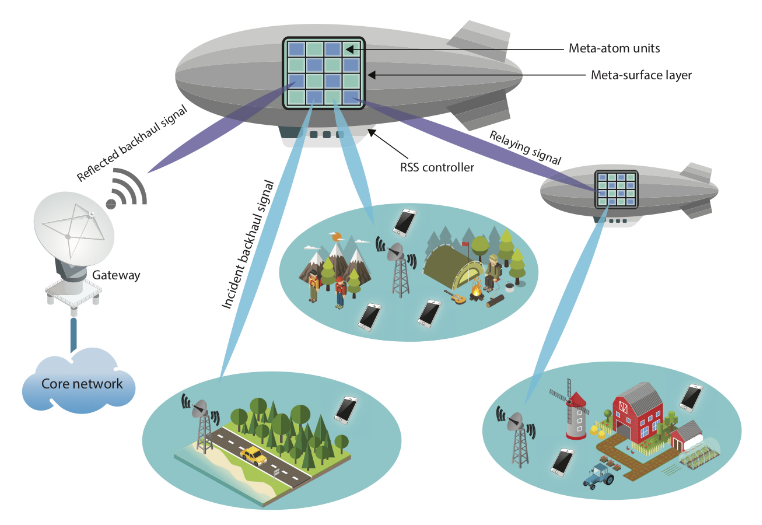Approximately 20 km up in the sky, High-Altitude Platform Stations (HAPS) literally take different forms, but the desired endgame is the same: greater connectivity on the ground. There is some debate as to where on the ground exactly, though.
A Little Bit Rural, A Little Bit Rock and Roll
“The main goal I’d say is to bridge the digital divide so as to enable connectivity everywhere in the world, especially the rural areas,” said Marco Giordani of the University of Padova’s Department of Information Engineering, talking to 6GWorldTM. “More than the rural areas, the remote areas, so where you have a lot of people that want to connect, you have the potential customers, but it’s going to be expensive to deploy typical network solutions.”
Part of the allure of HAPS is how they can provide connectivity in regions where deploying terrestrial networks is hard to do, and in some cases, impossible. In contrast, in a separate interview with 6GWorld, Professor Gunes Kurt of Istanbul Technical University suggested dense urban areas might be better fits for the technology. The lead author of a paper entitled “A Vision and Framework for the High Altitude Platform Station (HAPS) Networks of the Future,” Kurt opined why Alphabet’s Loon HAPS project may have been forced to shut down recently.
“The outcome of Loon is maybe related to how they were shooting for rural areas. From the business-model perspective, I think that also creates competition with SpaceX, like HAPS vs. satellites for coverage in rural areas. Of course, there are differences in terms of performance, but they can both do the job. If you look at a city that has millions of people that are trying to get service in a congested environment, HAPS may be more successful from the business side,” she said.
Loon, a subsidiary of Google’s parent company Alphabet, used balloons as the means to elevate base stations. In contrast, companies like Deutsche Telekom and HAPSMobile (SoftBank) have been trialing HAPS designed as remotely piloted unmanned aircraft, which are more complex and consequently more expensive. Regardless, the cost to deploy HAPS is much cheaper than Low-Earth Orbit (LEO) satellites, in part leading to interest and research in the sector. Compared to LEOs, HAPS are closer to the ground, leading to lower latency. They also offer greater control, as changing the orbital planes of LEO satellites can’t exactly be done at the drop of a hat. Kurt illustrated further.
“When we look at the Internet it works very well, but it has this structure where all the routers are almost always fixed. What if one router was moving away and you want to change the configuration? You need to do quite a bit of maintenance to support it,” she said. “[HAPS are] relatively slow-moving up in the sky compared to the LEO satellites that will spend seven minutes on a continent and then seven minutes on an ocean, where there will be no users at all or just a few ships around.”
Stargazing for Constellations
Hence the need for LEO constellations and having to deal with handovers between satellites. Even so, with the dramatically lower costs associated with HAPS as a result, there are other issues that must be mitigated before they could take off as a widespread connectivity solution. For example, their relative lifespan is short. In the case of a balloon-based deployment it’s mere months, according to Giordani. So, it makes little sense to use expensive equipment, which leads to another problem altogether.
“You cannot equip these HAPs with very sophisticated antennas or with very sophisticated hardware, because [HAPS are] more open to atmospheric issues. So the hardware has to be simple and this means that the connectivity is also going to be unstable,” he said.
Gunes pointed to how the HAPSMobile “Sunglider” is powered by rechargeable batteries and solar panels, which undeniably help. In the aforementioned paper, she and her fellow researchers actually suggested a different solution to keep HAPS flying in the future: Reconfigurable Intelligent Surfaces (RIS), which would use less energy. Consequently, they could prolong the flight duration of HAPS equipped with them.

“Since there will be less power used, it can be used for other purposes,” she said, qualifying that there aren’t any of these surfaces commercially available right now. “If that is somehow possible, if we can form large surfaces with it, it will provide quite a bit of advantage. Another thing, there is these smart meta surfaces, the performance improves as we put more and more reflective intelligent surface units jointly on the same HAPS unit and there will be HAPS structures across quite a bit of real estate in the sky. So, we thought it [would be] possible to put a lot of these units up in the sky to improve communications.”
Projected 6G HAPS-enings
Furthermore, Giordani suggested integration with other platforms is vital for steady connectivity. He presented that option as an alternative to deploying a large number of HAPS out of cost concerns.
“In order to cover a large area, either you need to deploy a very large number of HAPs, which then can become quite expensive, or you need to figure out how HAPs can integrate with some other types of infrastructure in supporting the more heterogeneous network,” he said. “For example, HAPs can be used to relay the terrestrial signal from the urban area into the rural regions, but then it’s important to think about how a HAPS can actually communicate with this other urban area or how multiple HAPS can communicate together if they want to collectively provide the connectivity on the ground.”
In their paper, Gunes and her fellow researchers described a three-layer Vertical Heterogeneous Network currently under consideration for 6G, in which HAPS operate in conjunction with satellites, unmanned aerial vehicles (UAVs, colloquially known as drones), and terrestrial networks. HAPS would occupy the same middle layer as UAVs (but directly above them), between infrastructure on the ground and satellites in orbit.
Asked if HAPS have a future as standalone solutions, Gunes said potentially if good business models satisfied the needs of dense populations. Primarily though, she sees HAPS constellations as a key component of the larger network. There they can facilitate communication between satellites, help manage computational requirements of UAVs, and enable benefits such as high-capacity Internet access in urban areas.
“From this perspective, we tried to explain that the HAPS will serve as an additional layer for higher-populated urban areas. As a standalone solution, it has some advantages that will probably be visible with some use cases like drone-delivery networks that will be used more and more,” she said. “Other than that, we see [it] as an integrated part of a terrestrial network. Another thing that makes HAPS a bit more critical is the fact that, between the LEO-satellite layer emerging and the terrestrial network, this may serve as a good intermediate solution that will facilitate connection between these layers.”
Gunes said she expects HAPS to catch on over the next decade. However, she said it would realistically be twice as long before we see dense deployments, as the need to coordinate communication with the ground and address the needs of more and more people becomes increasingly prevalent. For his part, Giordani said it is a technology rife with potential, but it requires more of a long-term plan to become fully effective… and financially viable.
“I think it’s something that will become available in a not-short time frame, like it’s going to take at least one decade and that’s why this idea of rural coverage is headed toward beyond-5G research activities,” he said.
“I think that one of the main issues is that these companies and also the network operators still have to clarify what the market is going to be like, how they can earn something out of their deployments. The business is not really clear yet. So [the technology is] going to improve more and more in the future, but still it needs to be clear who is going to gain most from these deployments.”
Feature image courtesy of aapsky (via Shutterstock).







